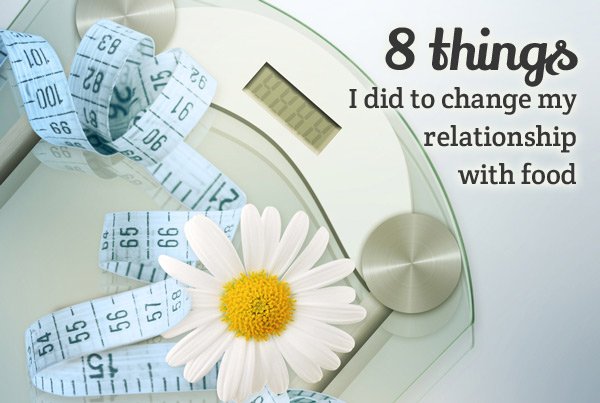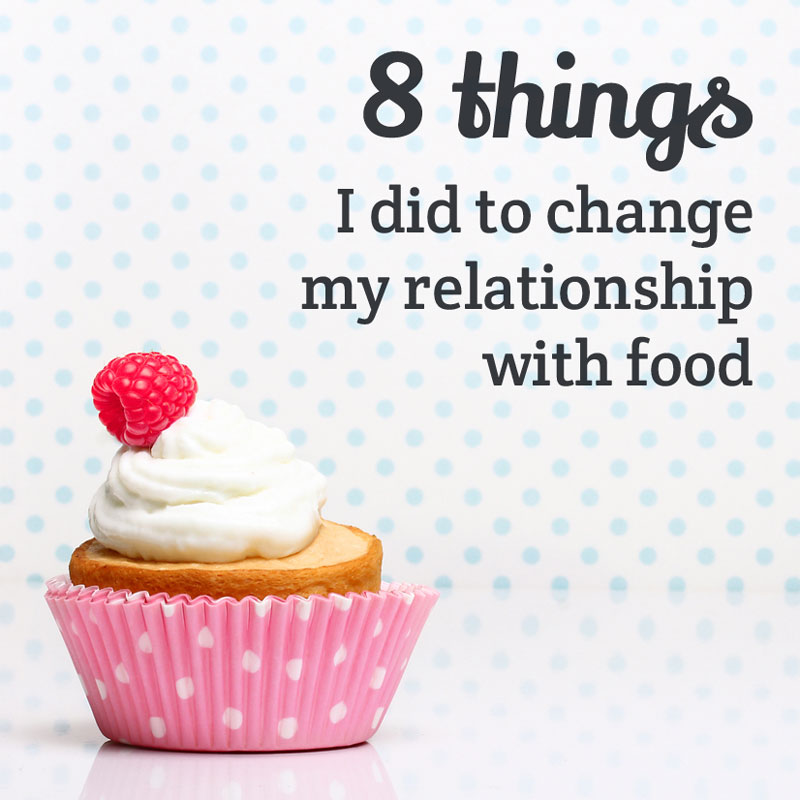
It’s probably a bit un-PC to admit this, but the way I look is important to me. I need to be a very certain weight/size to look in the mirror and be happy with what I see.
(Feel free to roll your eyes here and talk about how sad it is that I feel the need to conform to societal norms, but honestly, I don’t care. Being happy with what I see in the mirror makes me feel good and quite frankly, I like feeling good.)
Being my ideal weight/size has a natural enemy however, and that would be my love of food. For most of my life a pitched battle has raged between those two things.
Eventually that battle got so bad that, for roughly 20 of my 35 years on this earth, I spent every minute of Every Single Day obsessing about food. I’d go for a ride in the morning and spend the whole time thinking about what muffin I would eat at the coffee shop afterwards. The second I sat down at my desk at work I’d be wondering what I might have for morning tea. I’d be chowing down on said morning tea and already casting my mind towards lunch. Most days it would be rare for me to go for more than an hour without putting food in my mouth.
Was I even enjoying all this eating I was doing? Nope, because I was also weighing myself every morning (as soon as I woke up, but after a wee of course) and living and dying by what I saw. If the numbers were ‘good’, I’d carry on my merry way. If the numbers were bad I’d get depressed and angrily tell myself to exert some self-control dammit! And by morning tea that self-control would have been tested and found to be wanting. And I loathed myself for that lack of self-control.
I thought because I wasn’t anorexic or bulimic that I didn’t have a problem with food.
I was wrong.
If you’re thinking about food all day every day, then you have a problem with it.
It took me an awfully long time to realise this, but once I did, it gave me the kick in the butt I needed to do something about it. And so started the long and slow process of re-training the way my brain looked at food.
Here’s what I did to break the rather unhealthy cycle I was in. The below isn’t intended to be prescriptive, nor it is based on anything but a sample size of one (me). But since it worked for me maybe it will help others struggling with the relationship they have with food too.
STEP 1: I stopped looking at food as a reward for exercise
“I’ve gone for a three hour bike ride today so when I get home I can eat whatever I like.”
“I did a two hour run this morning so that totally justifies eating this entire pizza.”
While I do appreciate the health benefits (mental and physical) of exercise, for most of my life exercise has been a license to eat without fear of gaining weight. I know exactly how many calories I expend for any given exercise activity and for a long time I replaced those calories almost exactly with the food I was eating. If I had a day where I didn’t exercise (rare) I would get hugely anxious about what I put in my mouth and try to restrict my calorie intake. If I was successful in restricting my intake I felt deprived, and if I was unsuccessful I would hate myself for having no self-control. It was exhausting.
In the end it was just easier to make sure I exercised every day as it beat feeling deprived or hating myself.
That made the first step in re-training my brain pretty obvious: I needed to break up the relationship between exercising and eating.
I did this simply by consuming the same amount of calories every day (the baseline amount my body needed), regardless of whether I exercised or not.
Doing the above stopped me looking at food as a reward for doing exercise and killed my obsession with calories in vs calories out. It took a while but finally exercise became all about health and well-being for me and nothing to do with food.
STEP 2: I stopped having crap in the house
Human beings are funny. We don’t just eat to fuel our bodies to get through the day. No, we also eat out of boredom and when we’re emotional.I am no different to other humans in this regard so part of re-training my brain with regard to food meant I had to stop heading for the fridge whenever I got emotional or bored. This became particularly important when I started to work from home because it was a pretty short walk from my desk to the kitchen.
So what did I do?
I stopped having crap in the fridge or pantry. It took about 100 unsuccessful forays into the kitchen looking for a (now non-existent) sweet treat, but eventually my brain realised there was no point going there anymore. Now when I am upset I go for a walk and if I am bored I go on twitter
(I know people with kids will say but it’s a bit hard not to have crap in the pantry when you have kids. With all respect, if you shouldn’t be eating something because it’s crap, maybe your kids shouldn’t be eating that thing either?)
In short, if it’s not in your house, then you can’t eat it. Try it for a month and take note of how often you go foraging in the kitchen out of boredom. Trust me, you will find alternate cures for boredom and emotion when you can’t sate them with food!
STEP 3: I quit sugar
I am not keen to get into an argument here about whether sugar is evil or not (it is). But I will assert with confidence that most of the Western world eats too much sugar because frankly, it’s hard to avoid it. I know that I was certainly eating way too much of the stuff and I was keen to come off it for a while and see what it did for me. So I did Sarah Wilson’s I Quit Sugar program and here’s what I found:
- My digestive system, which had always been terrible, started to work much, much better (better poo, less popping off).
- The stomach bloating that used to plague me in the afternoons disappeared.
- I seemed to be carrying less fluid all over. This meant the muscles in my arms and legs looked more defined and I looked fitter than I actually was.
- I was eating more fat yet not gaining weight.
- My skin looked better.
- I found it much, MUCH easier to keep my weight stable.
- I stopped craving a sweet fix after every meal and in the evenings.
When I say ‘I quit sugar’ I mean I did Sarah’s program (which I found quite gentle and easy to do) and then once I was finished I stuck to the basic principles of it without being obsessive. I knew I really had sugar beat when I ate tomato sauce one day and it tasted grossly sweet to me. Up till that point I’d have tomato sauce on everything.
So I have stuck with the whole quitting sugar thing. For me it is a healthier way of eating … and one that doesn’t make me feel deprived.
STEP 4: I stopped eating low fat food
In line with the above, I stopped eating anything that was ‘low fat’ because ‘low fat’ simply translates to ‘we’ve replaced the fat with sugar’.
STEP 5: I changed the way I looked at fat
For years fat has been public enemy #1 and I, like everyone else, have avoided it like the plague. But fat has an awful lot of good points – the major ones being its satiety factor and the fact that our brains need fat to function. These days, instead of snacking on lollies I snack on nuts. I seem to be able to eat a LOT of nuts and avocado without gaining weight. Eating more fat also means I don’t feel hungry all the time.
STEP 6: I started eating before I got hungry
This one is pretty simple – I eat three regular meals at the same time each day. I don’t wait till I am starving before I eat because I make pretty terrible food decisions when I am starving. In between my three regular meals I snack on stuff like nuts, or avocado on toast. (I find it hard to over-eat either of those two things, but it’s super-easy to over-eat lollies.)
STEP 7: I stopped baking
If I bake it is generally something out of a packet and thus full of crap. Going by the photos I see on Instagram though, a LOT of what people bake is full of crap (sugar mainly), even when cooked from scratch. When I bake, two adults and one toddler polishes off whatever I bake in half a day. This isn’t healthy for anyone in my house so I decided to stop baking. Going back to #2 above, it seems that no-one in this house has self-control if there is crappy food at hand. Yet when the crap isn’t in the house, we don’t really miss it. So in the end there is no real hardship not having it there.
If you loooooove baking however and can’t bear the thought of stopping – then make it good stuff. Alexx Stuart has a blog full of real food/lox tox recipes. For instance check out her Anzac biscuit recipe here.
STEP 8: I started focusing on what I could eat rather than what I shouldn’t
Now I know what you’re thinking: Gee, what a deprived life you lead Kelly if you never get to eat yummy things anymore. Here are two reasons why I don’t feel deprived:
- I don’t spend a lot of time thinking about what I can’t eat. I focus instead on what I can. And believe me there is plenty of yummy stuff that I can eat that is healthy. As I mentioned above, I don’t miss the crap food when it’s not in my house. But if it is there and I try not to eat it, then I will feel deprived.
- Since I am not eating crap every day, when I am at a restaurant or a party and something yummy presents itself to me, I eat it AND enjoy it. Revolutionary! I can’t tell you how lovely it is to tuck into a piece of pavlova without thinking to myself gawd, I am going to have to run for an hour tomorrow to work this off.
So there you have it. On conservative estimate it took about two years for me to fully work through the above and break my obsession with food but now that I have, maintaining the weight I like to be has never been easier.
And honestly, life is a lot more fun when you’re not thinking about food every minute of the day.
Hello there! Just checking in to let you know I’ve written a follow-up to the post above here, all about creating good habits around food that help you spend less time thinking about food!.


